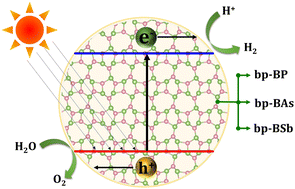Boron–pnictogen monolayers with a negative Poisson's ratio and excellent band edge positions for photocatalytic water splitting†
Abstract
Boron–pnictogen (BX; X = N, P, As, Sb) materials, in most cases, share structural characteristics with the aesthetically pleasing architectures of carbon allotropes. Recently, a two-dimensional (2D) metallic carbon allotrope (biphenylene) has been synthesized using experimental methods. In the present study, we have examined the structural stabilities, mechanical properties, and electronic fingerprints of biphenylene analogs of boron–pnictogen (bp-BX) monolayers using state-of-the-art electronic structure theory. We have validated the dynamical stability using phonon band dispersion analysis and thermal stabilities using ab initio molecular dynamics studies. The bp-BX monolayers exhibit a positive (bp-BN) and negative (bp-BP, bp-BAs, bp-BSb) Poisson's ratio with anisotropic mechanical properties in the 2D plane. Electronic structure studies unveil that the bp-BX monolayers show semiconducting properties with an energy gap of 4.50, 1.30, 2.28 and 1.24 eV for X = N, P, As and Sb, respectively. Computed band edge positions, lighter charge carriers and optimally separated hole and electron regions indicate that the bp-BX monolayers can serve as potential candidates for the metal-free water dissociation reaction using photocatalysis.



 Please wait while we load your content...
Please wait while we load your content...